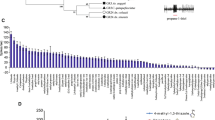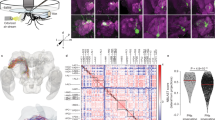Abstract
Sensilla basiconica on the maxillary palps of female Aedes aegypti contain a receptor neuron which produces a phasic-tonic pattern of action potential response to low concentrations (150–300 ppm) of carbon dioxide (CO2), a stimulus known to be involved with host seeking behavior. These receptor neurons respond reliably to small increments in CO2 concentration (e.g., 50 ppm). We were particularly interested in evaluating the possibility that the sensitivity to step increases in CO2 concentration could be modulated by alterations in the background levels of CO2, over a range which might be encountered during host-seeking behavior. We report here that the response (impulses/s) to a single pulse of a given concentration of CO2 appears to be independent of the background level of CO2, unless that level is equal to or greater than the concentration of the stimulus pulse. Females of other mosquito species, including: Anopheles stephensi, Culex quinquefasciatus, Culiseta melanura, and Aedes taeniorhynchus, also possess sensilla with receptor neurons that respond with comparable sensitivity to CO2 stimulation. However, there is much interspecific variation in both the external morphology of the maxillary palp and the distribution of sensilla along the palp. Male Ae. aegypti have morphologically similar sensilla which also contain a receptor neuron that responds to CO2.
Similar content being viewed by others
References
Acree F, Turner RB, Gouck HK, Beroza M (1968) L-Latic acid: a mosquito attractant isolated from humans. Science 161: 1346–1347
Akers RP, O'Connell RJ (1988) The contribution of olfactory receptor neurons to the perception of pheromone component ratios in male redbanded leafroller moths. J Comp Physiol A 163: 641–650
Bjostad LB, Gaston LK, Shorey HH (1980) Temporal pattern of sex pheromone release by female Trichoplusia ni. J Insect Physiol 26: 493–498
Bogner F (1990) Sensory physiological investigation of carbon dioxide receptors in Lepidoptera. J Insect Physiol 36: 951–957
Bogner F (1992) Response properties of CO2-sensitive receptors in tsetse flies (Diptera: Glossina palpalis). Physiol Entomol 17: 19–24
Bogner F, Boppre M, Ernst K-D, Boeckh J (1986) CO2 sensitive receptors on labial palps of Rhodogastria moths (Lepidoptera: Arctiidae): physiology, fine structure and central projection. J Comp Physiol A 158: 741–749
Bogner F, Grant AJ, O'Connell RJ (1992) A potential kairomone stimulates pheromone-responsive receptor neurons in Utetheisa ornatrix (Lepidoptera: Arctiidae). J Chem Ecol 18: 427–439
Braverman Y, Hulley PE (1979) The relationship between the numbers and distribution of some antennal and palpal sense organs and host preference in some Culicoides (Diptera: Ceratopogonidae) from southern Africa. J Med Entomol 15: 419–424
Cardé RT (1984) Chemo-orientation in flying insects. In: Bell WJ, Cardé RT (eds) Chemical Ecology of Insects. Sinauer Associates, Inc. Sunderland, MA, pp 111–124
Carlson DA, Schreck CE, Brenner RJ (1992) Carbon dioxide released from human skin: Effect of temperature and insect repellents. J Med Entomol 29: 165–170
Christophers SR (1960) The imago: special senses and behaviour. In: Aedes aegypti (L.) The Yellow Fever Mosquito. Cambridge University Press, Cambridge, pp 530–547
Clements AN (1963) Adult feeding. In: The Physiology of Mosquitoes. Pergamon Press, Oxford, pp 128–150
Darian-Smith I, Johnson KO, Dykes R (1973) “Cold” fiber population innervating palmar and digital skin of the monkey: responses to cooling pulses. J Neurophysiol 36: 325–346
Davis EE (1977) Response of the antennal receptors of the male Aedes aegypti mosquito. J Insect Physiol 23: 613–617
Davis EE (1985) Insect repellents: concepts of their mode of action relative to potential sensory mechanisms in mosquitoes (Diptera: Culicidae). J Med Entomol 22: 237–243
Davis EE, Sokolove PG (1976) Lactic acid-sensitive receptors on the antennae of the mosquito, Aedes aegypti. J Comp Physiol A 105: 43–54
Daykin PN, Kellogg FE, Wright RH (1965) Host-finding and repulsion of Aedes aegypti. Can Entomol 97: 239–263
Edman JD (1979) Orientation of some Florida mosquitoes (Diptera: Culicidae) toward small vertebrates and carbon dioxide in the field. J Med Entomol 15: 292–296
Elkinton JS, Cardé RT (1984) Odor dispersion. In: Bell WJ, Cardé RT (eds) Chemical Ecology of Insects. Chapman and Hall, New York, pp 73–91
Friend WG, Smith JJB (1977) Factors affecting feeding by bloodsucking insects. Annu Rev Entomol 22: 309–331
Galun R (1977) Responses of blood-sucking arthropods to vertebrate hosts. In: Shorey HH, McKelvey JJ, Jr. (eds) Chemical Control of Insect Behavior. John Wiley & Sons, New York, pp 103–115
Gillies MT (1980) The role of carbon dioxide in host-finding by mosquitoes (Diptera: Culicidae): a review. Bull Entomol Res 70: 525–532
Grant AJ, O'Connell RJ (1986) Neurophysiological and morphological investigations of pheromone sensitive sensilla on the antenna of male Trichoplusia ni. J Insect Physiol 32: 503–515
Grant AJ, Mankin RW, Mayer MS (1989a) Neurophysiological responses of pheromone-sensitive receptor neurons on the antenna of Trichoplusia ni (Hübner) to pulsed and continuous stimulation regimens. Chem Senses 14: 449–462
Grant AJ, O'Connell RJ, Eisner T (1989b) Pheromone-mediated sexual selection in the moth Utetheisa ornatrix: olfactory receptor neurons responsive to a male-produced pheromone. J Insect Behav 3: 371–385
Hartberg WK (1971) Observations on the mating behaviour of Aedes aegypti in nature. Bull WHO 45: 847–850
Kellogg FE (1970) Water vapour and carbon dioxide receptors in Aedes aegypti. J Insect Physiol 16: 99–108
Kline DL, Takken W, Wood JR, Carlson DA (1990) Field studies on the potential of butanone, carbon dioxide, honey extract, 1-octen-3-ol, L-lactic acid and phenols as attractants for mosquitoes. Med Vet Entomol 4: 383–391
Kline DL, Wood JR, Cornell JA (1991) Interactive effects of 1-octen3-ol and carbon dioxide on mosquito (Diptera:Culicidae) surveillance and control. J Med Entomol 28: 254–258
Lacher V (1964) Elektrophysiologische Untersuchungen an einzelnen Rezeptoren für Geruch, Kohlendioxyd, Lufteuchtigkeit und Temperatur auf den Antennen der Arbeitsbiene und der Drohne (Apis mellifica L.). Z Vergl Physiol 48: 587–623
Lambertsen CJ (1968) The atmosphere and gas exchanges with the lungs and blood. In: Mountcastle VB (ed) Medical Physiology, vol I. CV Mosby, St Louis, pp 629–659
Loftus R, Corbiére-Tichané G (1981) Antennal warm and cold receptors of the cave beetle, Speophyes lucidulus Delar., in sensilla with a lamellated dendrite. I. Response to sudden temperature change. J Comp Physiol A 143: 443–452
Matheson R (1944) Handbook of the Mosquitoes of North America. Comstock Publishing, Ithaca, NY
Mayer MS, James JD (1969) Attraction of Aedes aegypti (L.): responses to human arms, carbon dioxide, and air currents in a new type of olfactometer. Bull Entomol Res 58: 629–641
McIver S (1971) Comparative studies on the sense organs on the antennae and maxillary palps of selected male culicine mosquitoes. Can J Zool 49: 235–239
McIver SB (1972) Fine structure of pegs on the palps of female culicine mosquitoes. Can J Zool 50: 571–576
McIver SB (1980) Sensory aspects of mate-finding behavior in male mosquitoes (Diptera: Culicidae). J Med Entomol 17: 54–57
McKeever S, Pound JM (1979) The mouthparts of female Corethrell brakeleyi and C. wirthi (Diptera: Chaoboridae). J Morphol 161: 157–168
O'Connell RJ (1975) Olfactory receptor responses to sex pheromone components in the redbanded leafroller moth. J Gen Physiol 65: 179–205
Smith CN, Smith N, Gouck HK, Weidhaas DE, Gilbert IH, Mayer MS, Smittle BJ, Hofbauer A (1969) L-Lactic acid as a factor in the attraction of Aedes aegypti (Diptera: Culicidae) to human hosts. Ann Entomol Soc Am 63: 760–768
Stange G, Diesendorf M (1973) The response of the honeybee antennal CO2-receptors to N2O and Xe. J Comp Physiol 86: 139–158
Steullet P, Guerin PM (1992) Perception of breath components by the tropical bont tick, Amblyomma variegatum Fabricius (Ixodidae) I. CO2-excited and CO2-inhibited receptors. J Comp Physiol A 170: 665–676
Takken W (1991) The role of olfaction in host-seeking of mosquitoes: A review. Insect Sci Applic 12: 287–295
Vickers NJ, Baker TC (1992) Male Heliothis virescens maintain upwind flight in response to experimentally pulsed filaments of their sex pheromone. J Insect Behav 5: 669–687
Wall C, Perry JN (1987) Range of action of moth sex-attractant sources. Entomol Exp Appl 44: 5–14
WHO Malaria Unit (1993a) World malaria situation in 1991. Weekly Epidemiological Record 68: 253–260
WHO Malaria Unit (1993b) Global malaria control. Bulletin of the World Health Organization 71: 281–284
Author information
Authors and Affiliations
Rights and permissions
About this article
Cite this article
Grant, A.J., Aghajanian, J.G., O'Connell, R.J. et al. Electrophysiological responses of receptor neurons in mosquito maxillary palp sensilla to carbon dioxide. J Comp Physiol A 177, 389–396 (1995). https://doi.org/10.1007/BF00187475
Accepted:
Issue Date:
DOI: https://doi.org/10.1007/BF00187475




